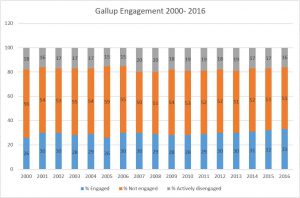
But while there are engagement surveys that do a good job of measuring symptoms, how well do we measure the underlying causes that lead to employee disengagement? How well are we identifying that the root cause originates at the management level?
Look at this graph derived from data published in Gallup’s State of the American Workplace. Since the Year 2000 employee engagement has hovered around 30%.

Yes, we have the ability to measure engagement factors. But what are the thousands of organizations that are measuring employee engagement doing to change things? Has the overall improvement been significant and noticeable? Can they prove that there is an increase in engagement? Has disengagement decreased? Without knowing if any of the measuring has, in fact, made a difference, the disillusionment in the executive office will continue.
For employees to be engaged, managers need to manage! And this requires an accountability and authority framework that is clear and implemented down and across the entire organization.
We partnered with the Telfer School of Business to develop a deeper understanding of the effectiveness of managers. Our research shows that managers in a cross-section of various sized organizations report spending only 55% of their time on value-added work. Almost half of their time is consumed doing work that is not adding value in the way it should and could.
We also found that while 98% of managers agree that they are held to account for their work, only 46% believed that they are delegated clear objectives with statements of quantity, quality, and timeliness.
This matters.
Based on our research, organizations generally fail to execute their strategies 70% of the time. Despite a clear vision and strategy, efforts become diffused and confused as work flows down and across the organization. Most managers and employees are working hard, but they fail to give sufficient attention to their value-added work, making them ineffective.
What are some of the symptoms of managers not doing their managerial work?
Poor communication – The right information is not getting to the right people at the right time.
Silos – Departments decide to “do it themselves” because they can’t trust their peers in other departments to deliver what was promised.
Conflict – People in different parts of the organization disagree on how and when they need to work together.
Meetings – There are too many meetings, revisiting the same issues instead of the accountable executive consulting, deciding, and directing.
Drift – The executive team decisions are not implemented consistently throughout the organization.
Indecision – People that should be making the decisions, do not. This results in delays, missed opportunities, and duplicated work.
Of the mentioned, what is the most glaring symptom? That’s right – it’s drift. In fact, according to the chief innovation officer at Kotter International, Dr. John Kotter, whose work is grounded in decades of empirical research conducted at Harvard Business School and is focused on identifying and building leadership potential throughout an organization, only 5% of organizations successfully implement their strategies. He tells Forbes that 70% of organizations fail to meet strategic initiatives while the remaining 25% do not meet the full potential of the strategy they’ve devised.
The question remains…After two decades of engagement measurement, are we making a difference?
We can help you create and sustain a high performance organization.
You can also check out our Engagement Infographic here. Or email me to set up a call.
Check out our YouTube channel for free VidCasts and recorded Webinars.




